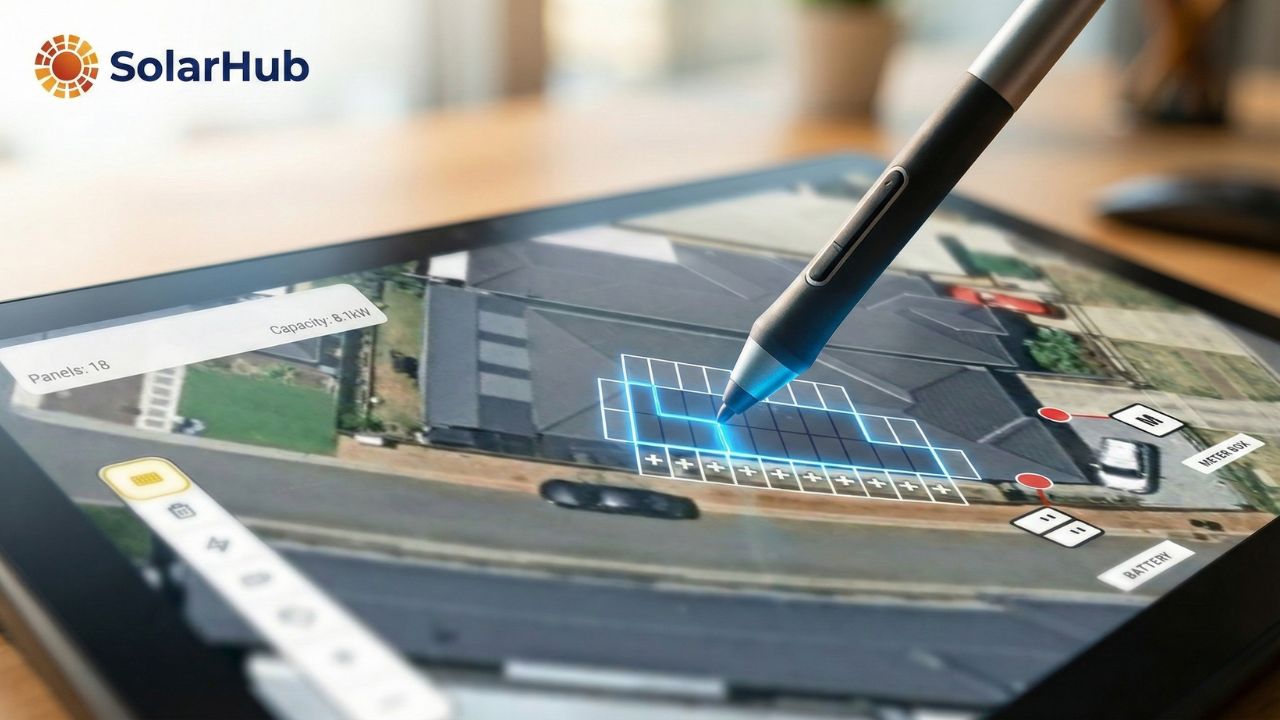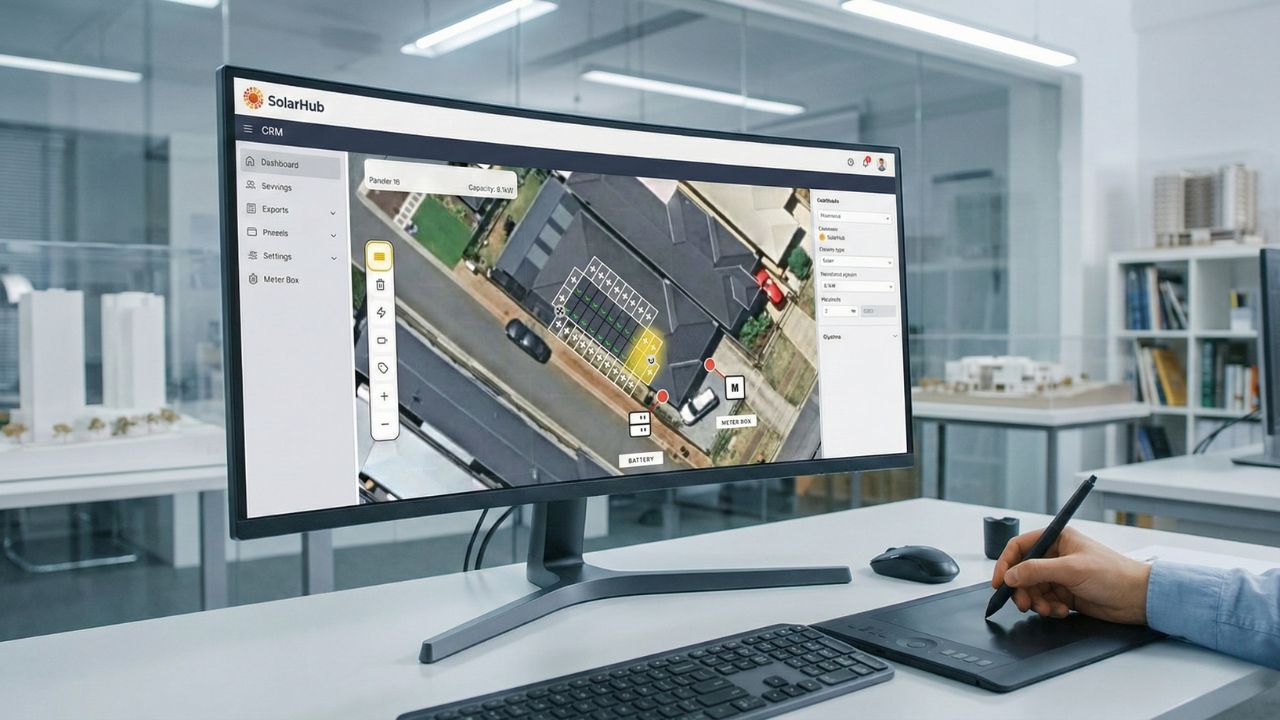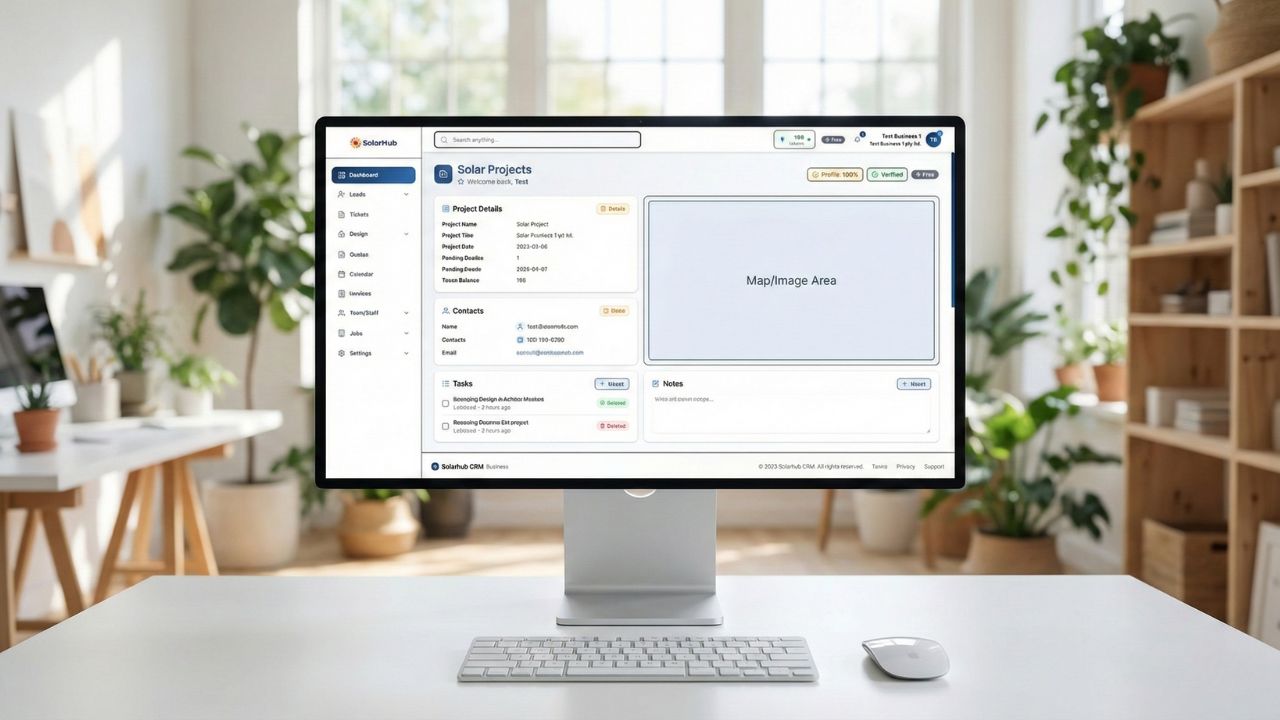Mastering Online Solar System Design in Australia: Your Ultimate Guide to Powering Up Your Home
Are you an Australian homeowner dreaming of reducing your electricity bills and embracing sustainable energy? The journey to a solar-powered home often begins with understanding how to effectively plan your system. In today's digital age, online solar system design has emerged as a powerful tool, revolutionising how Australians approach renewable energy. No longer do you need to wait for multiple in-person consultations; the future of custom solar solutions is at your fingertips.
From the sunny suburbs of Perth to the bustling cities of Sydney, Melbourne, Brisbane, Adelaide, and Hobart, Australia's abundant sunshine makes it a prime location for solar energy. But harnessing this power effectively requires careful planning. This comprehensive guide will walk you through everything you need to know about online solar system design, helping you make informed decisions for your Australian home. We'll explore the components, the process, the benefits, and how cutting-edge tools are making it easier than ever to achieve energy independence.
Why Online Solar System Design is a Game-Changer for Australians

Australia boasts some of the highest electricity prices globally, coupled with an incredible solar resource. This unique combination makes investing in solar panels and battery storage not just an environmental choice, but a financially smart one. However, the complexity of designing a system that perfectly matches your energy needs, roof space, and budget can be daunting. This is where the power of online solar system design truly shines.
Accuracy, Speed, and Customisation at Your Fingertips
- Precision Planning: Online tools allow for highly accurate simulations of your home's energy consumption and solar production. They consider factors like local weather patterns, shading from nearby trees or buildings, and roof orientation. This level of detail ensures your solar system is optimally sized and configured.
- Time Efficiency: Gone are the days of waiting weeks for multiple quotes and designs. With online solar system design, you can quickly explore different configurations, compare options, and receive preliminary proposals in a fraction of the time. This streamlines the entire process, getting you closer to installation faster.
- Tailored Solutions: Every Australian home is unique. Online platforms provide the flexibility to customise your system, whether you're interested in a basic grid-connected PV system or a comprehensive setup with advanced battery storage systems. You can experiment with different types of solar panels, inverters, and battery capacities to find what works best for you.
- Cost-Effectiveness: By optimising your design upfront, you can avoid costly errors and ensure you're investing in a system that delivers maximum returns. Understanding the financial implications, including potential savings and payback periods, becomes much clearer with detailed online proposals.
For homeowners across Australia, from Queensland to Victoria, utilising online resources for your solar design is a smart first step towards a more sustainable and affordable energy future. It empowers you with information and control, making the transition to renewable energy straightforward and transparent.
Understanding the Core Components of Your Australian Solar System
Before diving deep into the design process, it's crucial to understand the fundamental elements that make up a complete solar energy system. Knowing these components will help you make more informed decisions during your online solar system design journey.
1. Solar Panels (Photovoltaic Modules)
The stars of the show! Solar panels convert sunlight into electricity. In Australia, you'll typically encounter:
- Monocrystalline Panels: Known for their high efficiency and sleek, black appearance. They perform well in strong sunlight and are a popular choice.
- Polycrystalline Panels: Slightly less efficient but more budget-friendly, often with a blue hue.
- Thin-Film Panels: More flexible and lightweight, but generally less efficient and require more space. Less common for residential rooftops.
Australian companies like Tindo Solar even manufacture panels right here, offering high-quality, locally-made options for your photovoltaic systems.
2. Inverters
Inverters are the brains of your solar system, converting the direct current (DC) electricity generated by your panels into alternating current (AC) electricity that your home appliances use and that can be fed into the grid.
- String Inverters: Most common, connecting groups ("strings") of panels. Cost-effective but a single point of failure.
- Microinverters: One inverter per panel, maximising individual panel output and improving system resilience. Ideal for roofs with shading issues.
- Hybrid Inverters: Combine a solar inverter and a battery inverter, allowing you to connect solar battery storage directly. Essential for grid-connected pv systems with battery backup.
3. Battery Storage Systems
While not mandatory for a grid connect system, battery storage is increasingly popular in Australia. It allows you to store excess solar energy generated during the day for use at night or during power outages. This significantly boosts your energy independence and maximises self-consumption. When you install battery storage, you are essentially creating your own personal energy reserve.
4. Mounting Systems
These secure your solar panels to your roof or ground. They must be robust enough to withstand Australia's sometimes harsh weather conditions, including high winds and extreme temperatures. Online solar system design tools often incorporate structural considerations to ensure safe and compliant installation.
5. Monitoring System
Most modern solar systems come with monitoring capabilities, allowing you to track your energy production and consumption in real-time via an app or online portal. This helps you understand your system's performance and identify any potential issues.
Understanding these core components is the foundation of effective online solar system design. It allows you to appreciate the various options and configurations available, ensuring you select the best pv systems for your specific needs.
The Step-by-Step Guide to Online Solar System Design in Australia

Embarking on your online solar system design journey might seem complex, but by breaking it down into manageable steps, you'll find it incredibly empowering. This process is designed to help you plan your ideal gridconnected photovoltaic system.
Step 1: Assess Your Energy Needs and Goals
Before you even look at a solar panel, understand your current energy consumption. Gather your past electricity bills (ideally 12 months) to get an average daily or annual usage. Consider future changes: planning an electric vehicle? Adding a pool? Expanding your family? This will help determine the required system size for your solar energy needs.
Step 2: Site Analysis and Shading Assessment
Online solar system design tools use satellite imagery and 3D modelling to analyse your roof. They'll consider:
- Roof Orientation: North-facing roofs generally receive the most sun in Australia.
- Roof Pitch: The angle of your roof affects solar exposure.
- Shading: Trees, chimneys, neighbouring buildings, or even your own antenna can cast shadows. Accurate shading analysis is critical for optimising your solar panel layout.
- Available Space: How much usable roof area do you have for solar panels?
Step 3: System Sizing and Component Selection
Based on your energy needs and site analysis, the online tool will recommend an appropriate system size (e.g., 6.6kW, 10kW). You'll then select your components:
- Number and Type of Solar Panels: Balance efficiency with budget.
- Inverter Type: String, micro, or hybrid.
- Battery Storage: Decide if you want to install battery storage and, if so, what capacity. This is a key consideration for storage systems for gridconnected pv systems.
Many tools allow you to compare different options, showing you the projected performance and cost implications of each choice. This iterative process is at the heart of effective online solar system design.
Step 4: Layout and Optimisation
The tool will generate a visual representation of your solar system on your roof. You can often adjust the layout of the solar panels to avoid shaded areas, accommodate roof obstacles, and maximise aesthetic appeal. This is where the true 'design' aspect of pv systems design comes to life.
Step 5: Financial Analysis and Proposal Generation
Once you're happy with the design, the tool will provide a detailed proposal. This typically includes:
- System specifications and total cost.
- Projected annual energy production.
- Estimated savings on electricity bills.
- Payback period and return on investment.
- Information on government rebates and incentives available in Australia.
For the most accurate financial projections, ensure you provide your current electricity tariff details.
Step 6: Compliance and Professional Consultation
While online tools empower you with design capabilities, actual design and install requires adherence to Australian standards (AS/NZS 5033, AS/NZS 4777.2, etc.) and local regulations. A professional, SAA accredited grid installer will review your online solar system design, conduct a physical site inspection, and ensure all aspects meet safety and compliance requirements before installation. They will handle the necessary paperwork for grid connection and any state-specific programs.
Leveraging Advanced Online Tools for Precision Design (Introducing Solarhub's Edge)
The quality of your online solar system design hinges on the tools you use. Leading platforms offer far more than just basic panel placement; they provide a comprehensive suite of features that empower both homeowners and solar professionals. This is where dedicated Australian platforms like Solarhub truly shine, offering an integrated approach to solar system management and design.
What to Look for in a Top-Tier Online Design Tool:
- 3D Modelling & Visualisation: Realistic renderings of your home with solar panels, allowing you to see exactly how your system will look.
- Accurate Energy Simulations: Advanced algorithms that predict energy generation based on historical weather data, shading analysis, and panel specifications.
- Component Libraries: Access to a wide range of solar panels, inverters, and battery storage systems from various manufacturers.
- Financial Calculators: Detailed projections of costs, savings, and payback periods, often incorporating local Australian rebates and incentives.
- Proposal Generation: The ability to create professional, detailed proposals that clearly outline the system design, components, and financial benefits.
Solarhub: The All-in-One Platform for Australian Solar Professionals
While you, as a homeowner, might use various online tools for initial exploration, solar retailers and installers in Australia rely on powerful, integrated platforms to manage the entire customer journey from lead to installation. Solarhub is precisely this kind of solution, designed specifically for the Australian solar industry. It replaces fragmented workflows with one beautiful, integrated system, making it easier for professionals to provide you with an exceptional online solar system design experience.
Imagine a solar provider who can:
- Efficiently Manage Leads: Track and nurture every opportunity, ensuring no inquiry for solar panels or battery storage is missed.
- Generate Professional Solar Proposals: Create accurate, data-rich quotes with detailed calculations directly from their design. This means transparent and reliable information for you.
- Streamline Communication: Utilise automated email marketing campaigns and follow-ups, keeping you informed every step of the way.
- Smart Integrations: Connect with tools like Facebook and Google Sheets for seamless data flow, ensuring they have all the information needed to tailor your solar system design.
- Effortless Job Scheduling: Calendar sync and appointment booking features mean your site visits and installations are managed smoothly.
- Collaborate Internally: Team management features, including roles, permissions, and lead allocation rules, ensure that the right expert is always working on your project, from systems design to installation.
When you engage with a solar company using a platform like Solarhub, you benefit from a highly organised, efficient, and professional service. This ensures that your online solar system design is not just a drawing, but a well-managed project from start to finish. When you fill out an online form with your name your email phone submit details to request a quote, you can be confident that a robust system is in place to handle your inquiry efficiently. For the best experience with interactive online tools and forms, ensure your javascript in your browser is enabled, allowing you to complete this form and interact fully with the platform.
Navigating Australian Solar Accreditation and Training for Professionals

While homeowners can explore online solar system design, the actual installation and final sign-off of any gridconnected pv systems in Australia must be carried out by Clean Energy Council (CEC) accredited professionals. This is a critical aspect of ensuring safety, quality, and eligibility for government incentives.
The Importance of Accreditation in Australia
- CEC Accreditation: The Clean Energy Council (CEC) sets the standards for the design and installation of solar and battery systems in Australia. Choosing a CEC accredited installer and designer is paramount for your peace of mind and to ensure your system is eligible for the Small-scale Renewable Energy Scheme (SRES) rebates.
- Solar Accreditation Australia (SAA): SAA is the new accreditation body appointed by the Australian government to manage the accreditation of solar and battery installers and designers. Professionals must be SAA accredited to participate in various programs, ensuring high standards are maintained.
- AS/NZS Standards: All installations must comply with strict Australian and New Zealand Standards, such as AS/NZS 5033 (Installation and safety requirements for photovoltaic (PV) arrays) and AS/NZS 4777.2 (Grid connection of energy systems via inverters).
Training and Qualifications for Solar Professionals
Behind every expertly designed and installed solar system is a qualified professional. Many undertake specific solar design course and training to achieve their accreditation. These often include:
- UEE Certificate III in Electrotechnology Electrician: A foundational qualification for electricians, often a prerequisite for solar accreditation.
- UEE Certificate IV in Grid-Connected PV Systems Design: Specific training for the design of gridconnected pv systems design, covering advanced concepts and compliance.
- Battery Storage Systems for Grid-Connected PV Systems Design & Install: Specialised courses focusing on the safe and effective integration of battery storage systems.
Organisations like Energy Training Group and GSES provide these essential energy training courses, ensuring a skilled workforce. When you're looking for a solar provider, always ask about their accreditation and qualifications. This ensures your online solar system design is brought to life by true experts.
Your Future is Bright with Online Solar System Design in Australia
The journey to a cleaner, more affordable energy future for your Australian home is more accessible than ever, thanks to innovations in online solar system design. By leveraging these powerful tools, you can gain a deep understanding of your energy needs, explore various system configurations, and make informed decisions with confidence. Whether you're in Melbourne, Adelaide, or any other part of this sunburnt country, the ability to customise your solar system and visualise its impact is a true game-changer.
Remember, while online tools provide an incredible foundation, the expertise of CEC and SAA accredited professionals is indispensable for the final design install and safe operation of your gridconnected pv systems. They ensure your system meets all Australian standards and maximises your long-term savings.
Ready to take the next step towards energy independence? Empower your solar business with the tools that make precision design and seamless project management a reality. For Australian solar retailers and installers looking to streamline their operations, from lead management to professional solar proposals, Solarhub is your all-in-one solution.
Discover how Solarhub can transform your solar business today!


